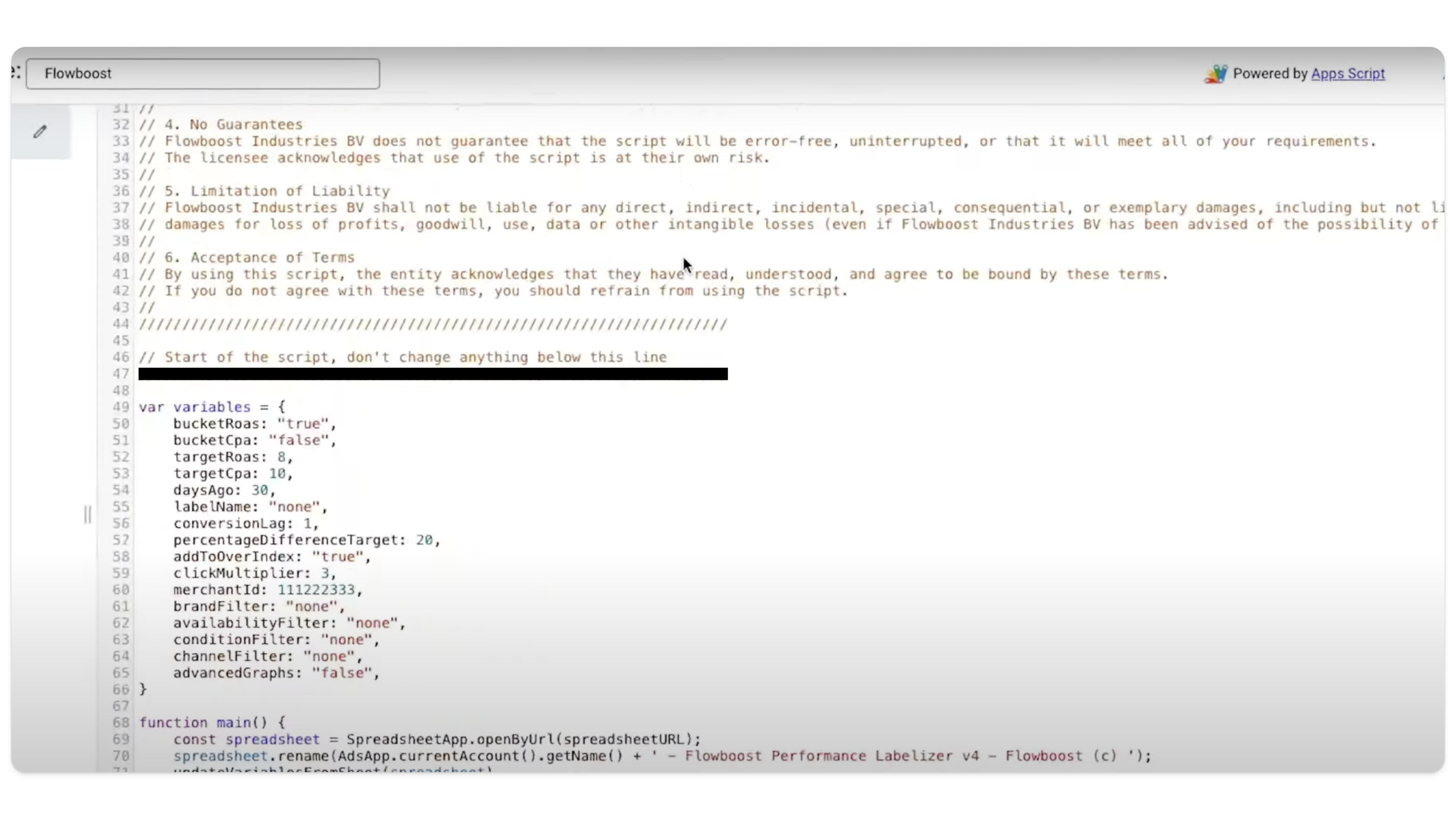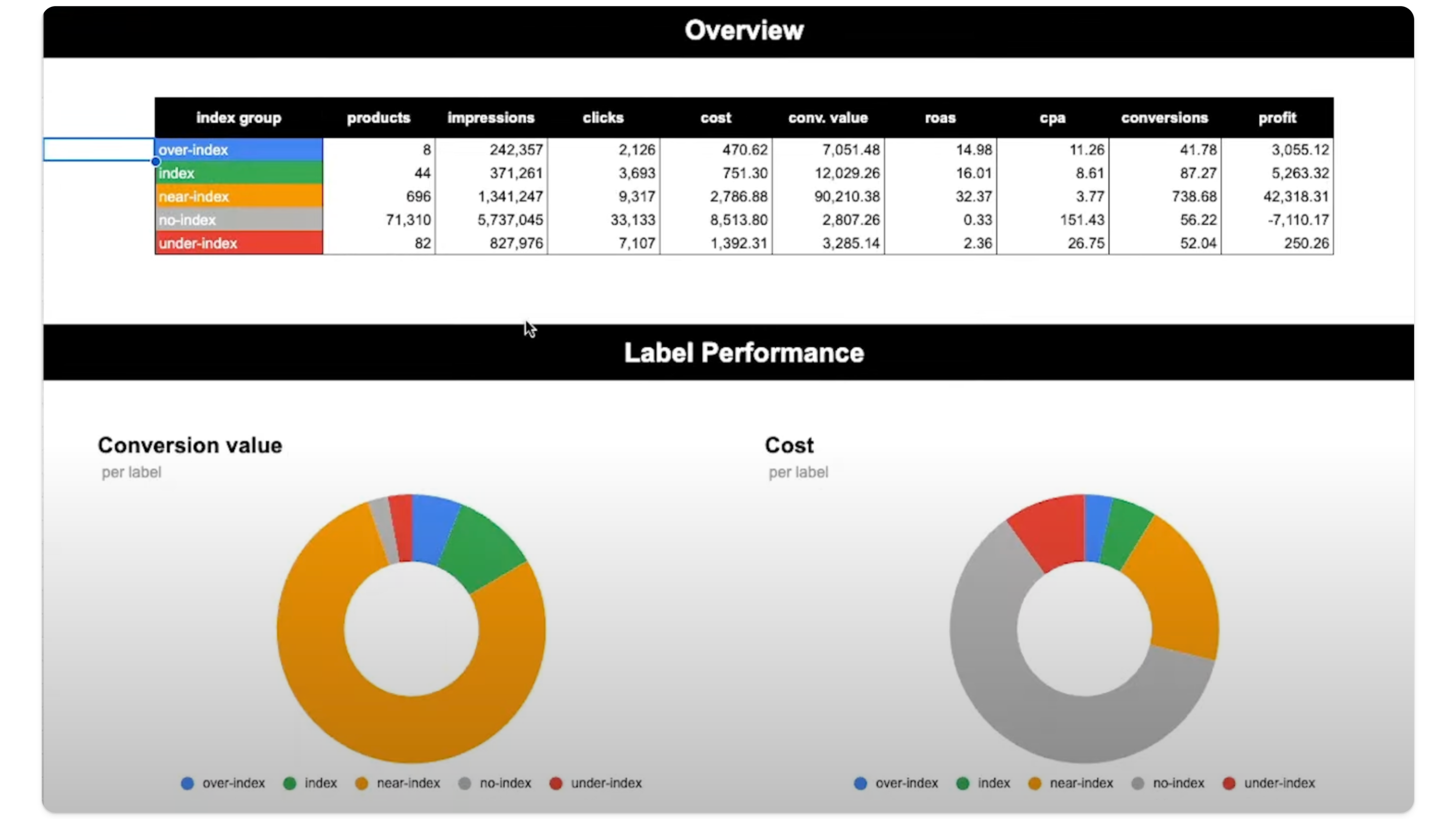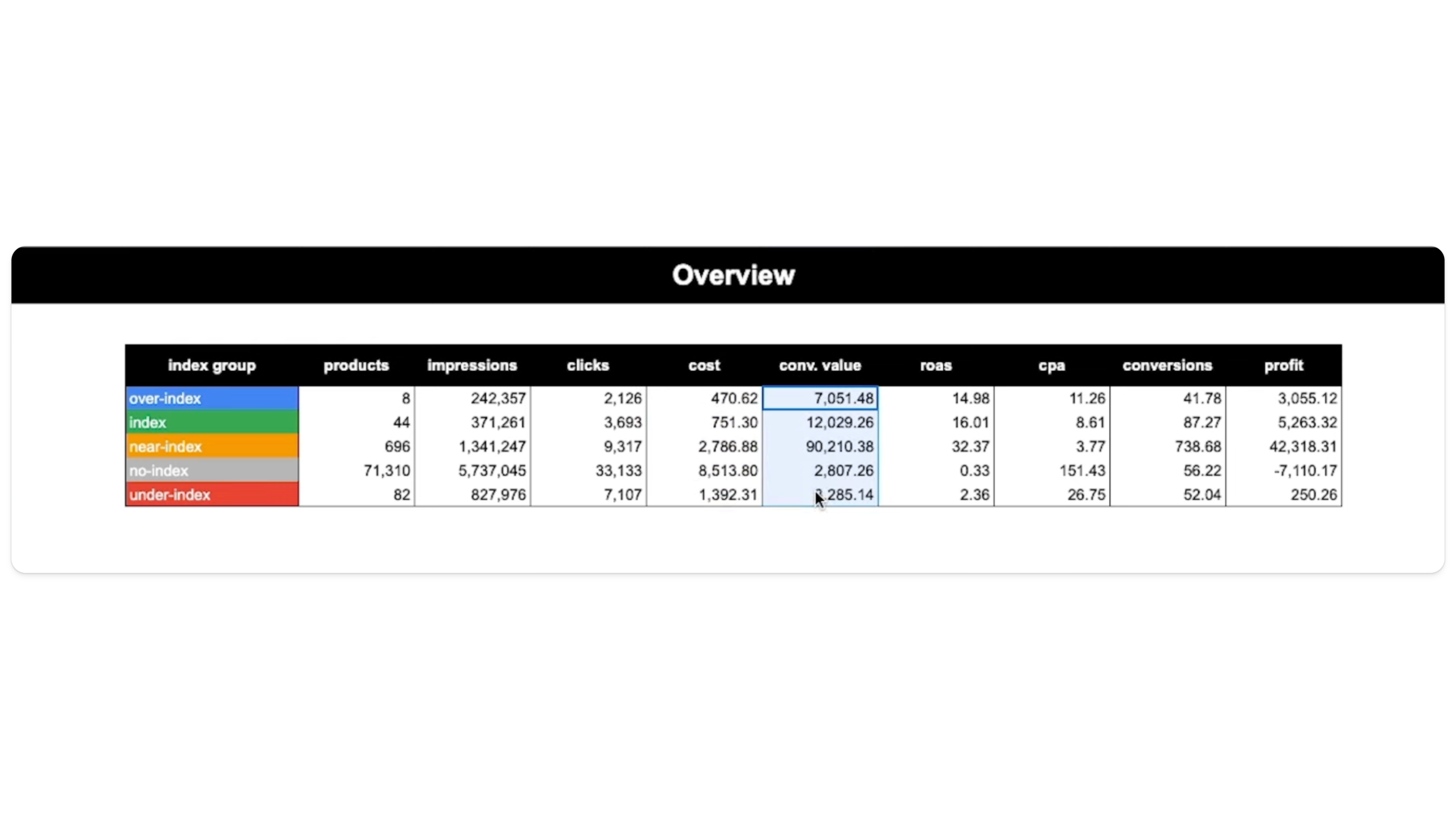At Grow My Ads, we have a lot of eCommerce clients, and manage millions of dollars in eCommerce ad spend every month. Some of these clients have a lot of SKUs. Now we’re all for that, but the problem is this: the bigger the product catalogue, the harder it becomes to know what’s actually working.
Once you get into the thousands, tens of thousands, or millions of SKUs, identifying which products are generating revenue — and which are costing money without adding value — is essential, but it’s almost impossible without automation.
Enter the FlowBoost Labelizer script, an invaluable tool for high-SKU eCommerce brands. In this post, we’ll review exactly how this script enables smarter ad spend (and unlocked millions for our eCommerce clients).
Prefer video? Watch here instead:
Still with us? Good. Let’s dive in.
The eCommerce Google Ads Scaling Problem
Let’s set the scene: You’re managing an eCommerce Google Ads account with thousands of SKUs — maybe even tens or hundreds of thousands. Some products are crushing it, others are bleeding money, and most fall somewhere in between. You know you should be optimizing based on performance, but with that many products, where do you even start?

We faced this exact challenge with a client who had over 70,000 products in their feed. Try manually categorizing that! You’d need a small army of analysts working around the clock, and by the time you finished, the data for their ad campaigns would already be outdated.
Performance Max campaigns make this even trickier. Your products are showing up across YouTube, Display, Search — you name it. Each platform affects your metrics differently. A product might have a great conversion rate on Search, but tank on Display. How do you account for all these variables when you’re dealing with thousands of SKUs?
Enter FlowBoost Labelizer
That’s where FlowBoost Labelizer comes in. We stumbled across this script (and no, we have no affiliation with the creators — we’re just big fans), and it’s completely transformed how we run Google Ads for high-SKU accounts. Just a heads up, we’re using the paid version of the script, so all of our advice will be based on that.

The magic of this script lies in its ability to automatically categorize your products into performance-based groups.
The Five Performance Categories
Over-Index: These are your rock stars — the products that consistently outperform your baseline goals in Google Ads. Think of these as your MVP products, in that they’re high-value over-performers.
Index: Your solid performers — they’re hitting your baseline Google Ads goals reliably. Not spectacular, but definitely worth keeping in the rotation.
Near-Index: The products show promise — they’re close to your Google Ads baseline goals and might just need a little optimization to become winners.
Under-Index: These are money-suckers — these products underperform and eat into your profits from Google Ads. They need immediate attention.
No-Index: Products without enough data to categorize. These need more time or focused testing to determine their potential.
Flowboost Labelizer: Real Numbers From a Real Account
Here’s actual data from one of our client accounts with roughly 70,000 SKUs over a 30-day period:

Total Account Performance:
Ad Spend: $14,000
Revenue: $115,000

But things get really interesting when we break the Google Ads account down by category:
Over-Index (8 products total):
Spend: $470.62
Revenue: $7,051.48
Notable: 14.98 ROAS (return on ad spend)
Index (44 products):
Spend: $751.30
Revenue: $12,029.26
Notable: 16.01 ROAS (return on ad spend). These are our clients’ consistent performers with strong profit margins.
Near Index (696 products):
Spend: $2,786.88
Revenue: $90,210.38
Notable: A very high ROAS (return on ad spend), at 32.37. This group also generated the majority of our revenue.
Under-Index (82 products):
Spend: $1,392.31
Revenue: $3,285.14
Notable: Clear candidates for optimization or removal.
No-Index (remainder of catalog):
Spend: $8,513.80
Revenue: $2,807.26
Notable: Largest group by SKU count (at 71,310 products), lowest performance. When you have a lot of products, there will be a significant number of them that will only ever get a few clicks. With just a few clicks, they will never be big movers. Review the products and product categories that fall within this No-Index range in your Google Ads account to determine a plan for the account going forward. And remember, just because a product isn’t achieving ROAS goals now does not mean it never will.
Turning Data Into Action
This Flowboost Labelizer breakdown completely changed our approach to Google Ads management.

Here’s how we used this information:
1. Campaign Restructuring
Instead of organizing Google Ads campaigns by product category alone, we started creating campaign structures based on performance labels. This allowed us to:
Allocate higher budgets to Over-Index and Index products
Create specific testing campaigns for promising Near-Index products
Carefully monitor and optimize Under-Index products
Develop a strategic approach for No-Index products
2. Seasonal Pattern Recognition
The Flowboost Labelizer script runs continuously, and we started noticing seasonal patterns:
Products moved between categories during different seasons
Some items consistently performed better during specific times of year
Other products needed different strategies during peak versus off-peak periods

This meant we could maximize budget efficiency during key selling periods for our client.
3. Budget Allocation
We completely revamped our budget allocation strategy in our client’s Google Ads account by:
Prioritizing spending on Over-Index and Index products
Creating separate testing budgets for No-Index products
Implementing stricter ROAS requirements for Under-Index products
Advanced Implementation Strategies
After running this script for ads for eCommerce across multiple Google Ads accounts, we’ve developed some best practices:
For Over-Index Products (Your Stars):
Create dedicated campaigns with higher budgets
Test expanding to additional networks
Experiment with aggressive bidding strategies
Conduct regular search term analysis to find new opportunities
For Index-Products (Steady Performers):
Focus on maintaining performance
Regularly optimize your bid
Test similar audiences to expand reach
Monitor for seasonal trends
For Near-Index Products (Potential Winners):
Regularly test different ad formats
A/B test product titles and descriptions
Closely monitor performance trends
Analyze successful versus unsuccessful days
For Under-Index Products (Underachievers):
Dive deep into pricing strategy
Analyze competitor offerings
Review product feed quality
Test different audience segments
For No-Index Products (The Unknown):
Create testing frameworks
Set clear evaluation periods
Define success metrics
Regularly review products moving between categories
Implementation Tips and Tricks
After running this script across various Google Ads accounts, here are some pro implementation tips for your Google Ads campaigns:
Start With Clean Data: Before running the script, ensure your Google Ads product feed is clean and properly organized. This makes the categorization much more meaningful.
Set Realistic Timeframes: While you can run the script for any time period, we’ve found 30-day windows provide the most actionable data for most Google Ads accounts.
Consider Seasonality: Create separate labels for seasonal products to avoid skewed data during off-peak times.
Regular Monitoring: Check the script’s output at least weekly to catch any significant performance changes early.

Client Communication: Use the script’s data to have more productive conversations with clients (or your team) about the product strategy.
The Future of High-SKU Management
The beauty of FlowBoost Labelizer isn’t just in its current functionality — it’s in how it evolves with your account. As performance changes, products automatically move between categories, ensuring your optimization efforts always focus on the right areas.
This dynamic approach to product management is especially crucial as eCommerce continues to grow and product catalogs expand. Manual management simply isn’t scalable, and basic automation isn’t sophisticated enough to handle the complexities of modern eCommerce Google Ads campaigns.
Ready to Try It? Here’s How to Get Started
While there’s a free version of Flowboost Labelizer available, we recommend going for the paid version if you’re managing any significant eCommerce business accounts. The additional configuration options and flexibility are well worth the investment.
With the paid version of the Google Ads eCommerce script, you can:
Customize date ranges for analysis
Set different performance thresholds
Create custom labels based on your needs
Export detailed reports for client presentations
Final Thoughts
In the hyper-competitive world of eCommerce advertising, you’re only as good as your data. FlowBoost Labelizer has transformed how we approach Google Ads for eCommerce stores with high-SKU accounts, turning overwhelming product feeds into organized, actionable campaigns.

Is it the only tool you need? No. But for accounts with large product catalogs, it’s become an indispensable part of our optimization toolkit. The clarity it brings to product performance has helped us unlock significant revenue growth for our clients, and more importantly, it’s given us a scalable way to manage even the largest eCommerce Google Ads accounts effectively.
Whether you’re managing thousands of SKUs or millions, having a systematic way to evaluate and categorize product performance isn’t just helpful — it’s essential for optimizing your Google Ads account. And in our experience, FlowBoost Labelizer is one of the best tools out there for making that happen.



